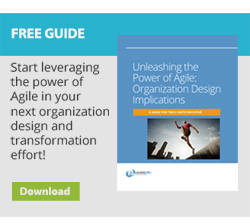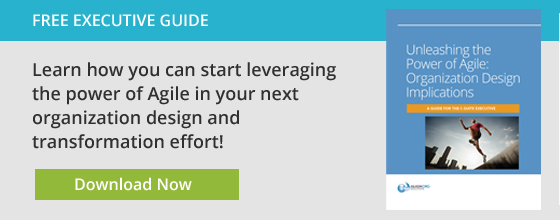The world today is experiencing a faster rate of change than ever before. Technological advancement is happening at lightning speed, and this is causing ripple effects throughout organizations, talent, culture, and nearly all aspects of organizational life. As leaders respond to and anticipate in this level of change, they often develop a “what if” mindset when it comes to making choices for the organization: “What if next year we grew? What if we acquire another company? What if we are acquired?”
The very real concern associated with this practice is that any kind of substantial organization choice based on a prediction of what might come can easily prove to be wrong within in a fairly short amount of time. What made sense a few months ago might be completely off base going forward. No wonder so many organizations desire and seek flexibility in their organization designs.
Flexibility as an Organization Design Principle
There are tactics and techniques leaders and organizations can adopt that support the design of adaptive organizations. When implemented, the following organization design ideas allow a company to have flexibility and adapt more readily to changes within and outside of the organization.
Evaluating Organization Design Choices for Flexibility
One excellent way to build flexibility into your company is to make it one of the design criteria for your organization. This encourages leaders to evaluate choices based on whether or not they allow the organization to flex and adapt.
For example, when considering a new technology, leaders can ask, “Are we installing a technology that can expand if we were to acquire someone? Can it expand or adapt if we change our products or services? Can the technology grow with us as our organization evolves?” While these kinds of questions don’t always give definitive answers, they help ensure that the organization is thinking beyond the moment or the immediate situation and is considering the consequences of potential organization realities in the future.
Modular Design Structures
In any given organization, certain organization structure options will prove more flexible than other available options. These might not be the same from one organization to the next. For instance, organizing work around a functional grouping can create a lot of flexibility in some situations. A function can operate across many parts of an organization, allowing all to benefit. If a new company is acquired, that function can be shared with that new business with only incremental changes. However, being set up as a function can also be a limiting factor in other situations, such as when different business units have distinct differences that a single function can’t support effectively.
Another example is a company that organizes itself around customers rather than functions. Doing this allows the company to add or divest customer business units as needed to meet strategic priorities and opportunities. As an example, one of our clients recently announced they are going to spin off a business, and it will be relatively easy for them to do because they are organized in a highly modular way.
Flexible Ways of Working
The way we structure work promotes either flexibility or rigidity. One highly flexible way of doing work is to use an Agile approach. Agile makes use of ways of working that are quick, flexible, and responsive. It is also highly compatible with a modular structure, because the quick work sprints that Agile calls for naturally bring the right people together to do high-value work and then divert them to other business essential activities when finished.
The great benefit of using Agile ways of working in an environment of change is that by operating in a more Agile fashion—in bursts, short doses, and concentrated work efforts—if something’s not going to work it usually becomes quickly apparent. And if it turns out the work is misdirected, it’s not a life sentence. It just calls for a shift. People can be moved around or the scope of the project changed on short notice relatively easily, as opposed to working in a more waterfall or linear fashion which requires a longer-term commitment and may not surface misalignments until well into the work effort.
Flexibility Facilitates Resilience
An adaptable organization is one whose internal and external structures enable it to flex readily in response to change. This is unlikely to happen by chance. By intentionally making organization design choices that encourage flexibility in structure and work processes, leaders can build an adaptive organization that remains resilient and competitive in a changing business environment.






